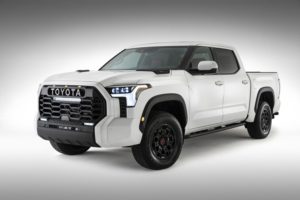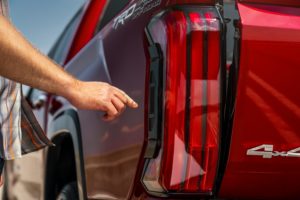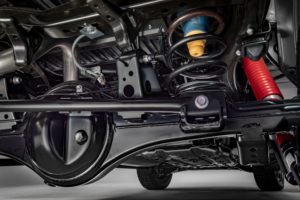
2022 Toyota Tundra features stronger frame, composite pickup bed
By onAnnouncements | Technology
Toyota on Sunday revealed its all-new 2022 Tundra, which incorporates a new high-strength, boxed, steel-ladder frame, an aluminum-reinforced composite pickup bed and a fully redesigned multi-link rear suspension in its design.
Beneath its “Technical Muscle” looks, created by Toyota Motor Corporation’s North American design studio, Calty Design Research, in Newport Beach, Calif., the Tundra features a number of changes of particular interest to repairers.
“High-strength steel is employed throughout the chassis to increase rigidity considerably over the previous generation, while aluminum is used in key areas to help reduce weight,” Toyota said. “Frame crossmembers are more than doubled in size to provide additional reinforcement and rigidity. A new front cross member was constructed for the steering gear box, which adds rigidity via additional cross member support while enhancing steering input for the driver and handling dynamics.”
“The truck bed is lightweight and extremely strong thanks to the new Sheet-Molded Compound (SMC) construction and the use of reinforcing aluminum cross members in the bed. The new SMC bed offers added protection against dents, impact dings and rust compared to traditional steel decks. Even the tailgate uses lightweight construction techniques to reduce weight by 20% compared to the outgoing model. Speaking of the tailgate, one of the coolest features is the tailgate release on the key fob that is standard on all models,” the automaker said.
Toyota noted that the rear frame member was widened to improve the vehicle’s stability and towing capacity, while also improving ride comfort. On grades above the basic Limited, the Tundra features hydraulic cab mounts for added occupant comfort.
The truck will offer several new tech features, Toyota said, such as towing aids, off-road enhancements, an all-new multimedia system featuring wireless Apple CarPlay and Android Auto and over-the-air updates. The Tundra will carry “several new cameras,” Toyota said, allowing occupants to see “multiple exterior angles” via the available 14-inch touchscreen or the available rear view mirror camera accessory.
 On TRD Pro or vehicles with the TRD Off-Road package added, an available “Multi-Terrain Monitor” will let the driver check the immediate surroundings for obstacles by pushing a button for front-, rear- and side-camera views. A “Panoramic View Monitor” will use cameras to display a top-down view of the truck, of particular interest to those towing a trailer.
On TRD Pro or vehicles with the TRD Off-Road package added, an available “Multi-Terrain Monitor” will let the driver check the immediate surroundings for obstacles by pushing a button for front-, rear- and side-camera views. A “Panoramic View Monitor” will use cameras to display a top-down view of the truck, of particular interest to those towing a trailer.
A panoramic roof is included among the interior options, as are heated and ventilated front seats, a rear sunshade, a heated steering wheel and more.
Offered as standard equipment on all Tundra grades will be Toyota Safety Sense 2.5, a package of active safety features. These include:
- The Pre-Collision System with Pedestrian Detection (PCS with PD): This feature has been enhanced to detect not only vehicles ahead, but a pedestrian in low light, a cyclist in daytime, or an oncoming vehicle and a pedestrian at intersections when making a turn. At intersections, the system is designed to detect an oncoming vehicle or pedestrian when performing a left-hand turn and provide audio/visual alerts and automatic braking in certain conditions. Other PCS functions include emergency steering assist, which helps stabilize the driver’s emergency steering maneuvers within their lane while avoiding a preceding pedestrian, bicyclist or vehicle.
- Dynamic Radar Cruise Control (DRCC): Lane Departure Alert will alert the driver if it senses that the truck is leaving its lane with no turn signal. With DRCC is set and engaged, Lane Tracing Assist (LTA) provides a slight steering force to help keep the truck in the center of its lane, using visible lane markers or a preceding vehicle.
- Automatic High Beams: These detect preceding or oncoming vehicles and automatically switch between high- and low-beam headlights. Road Sign Assist (RSA) recognizes certain road sign information using a forward-facing camera, and displays that information for the driver to see.
- Rear Seat Reminder: If a rear door has been opened within 10 minutes of the vehicle being turned on, or at any time after the vehicle has been turned on, the driver will get a reminder in the instrument cluster after the engine is turned off, accompanied by chimes.
All Tundras will also be equipped with Toyota’s Blind Spot Monitor (BSM), which is designed to warn of vehicles approaching or positioned in the adjacent lanes. Rear Cross Traffic Alert (RCTA) detects vehicles approaching from either side while the truck is backing out. The available Parking Support Brake is designed to apply brake control to avoid a collision with a stationary object or approaching vehicle, or while parking.
Not included in Toyota’s announcement was any mention of the new trucks’ headlights. The previous generation Tundra earned a Good rating from the Insurance Institute for Highway Safety for its LED reflector headlights, offered on high-end TRD models, and a Marginal rating for all others, which used a combination of halogen projector low beams, and halogen reflector high beams.
Toyota Safety Connect offers drivers a 24/7 emergency response agent who can send emergency services to a vehicle’s exact location, or help authorities find a stolen vehicle. Service Connect also provides drivers with maintenance updates, vehicle health reports and maintenance reminders.
The Tundra will be offered with two different four-door layouts, as well as a variety of bed lengths that include a 5.5-foot bed, a 6.5-foot bed and an 8.1-foot bed.
 Like the prior generation Tundra, the new truck will be assembled at Toyota Motor Manufacturing Texas (TMMTX) in San Antonio. It will go on sale later this year, Toyota said, with pricing to be announced closer to the on-sale date.
Like the prior generation Tundra, the new truck will be assembled at Toyota Motor Manufacturing Texas (TMMTX) in San Antonio. It will go on sale later this year, Toyota said, with pricing to be announced closer to the on-sale date.
Two powerplant configurations will be offered: a new, twin-turbo 3.5-liter V6 that makes up to 389 horsepower and 479 lb-ft. of torque; and that engine paired with a bellhousing electric motor system called the i-FORCE MAX, to give a combined output of 437 horsepower and 583 lb.-ft. of torque. Both configurations will be mated to a new 10-speed automatic transmission.
Research and development for this truck was conducted at Toyota Technical Centers in Michigan, Arizona and California. The goals for the chassis engineers, Toyota said, included improved capability and ride comfort. The solution included moving to a fully boxed frame, which the automaker said improved rigidity significantly compared to the current generation.
The new multi-link rear suspension replaces the previous truck’s leaf springs with coil springs. This helps raise the Tundra’s towing capacity to 12,000 pounds, 17.6% over the previous generation. The maximum payload is 1,940 pounds, an improvement of more than 11% from the previous generation.
Available on certain grades, a new air suspension system features automatic and manual leveling functions. It features height modes for High, Low and Normal for the rear suspension.
Images:
Featured image: The 2022 Toyota Tundra Crew Cab is shown. (Toyota Motor Sales, USA)
The tailgate of the 2022 Toyota Tundra weighs 20% less than the preceding model’s, thanks to innovative construction techniques, Toyota said. (Toyota Motor Sales, USA)
The new multi-link rear suspension of the 2022 Toyota Tundra is shown. (Toyota Motor Sales, USA)
